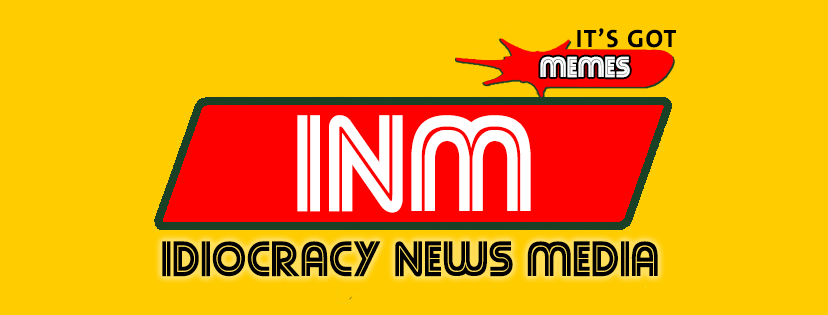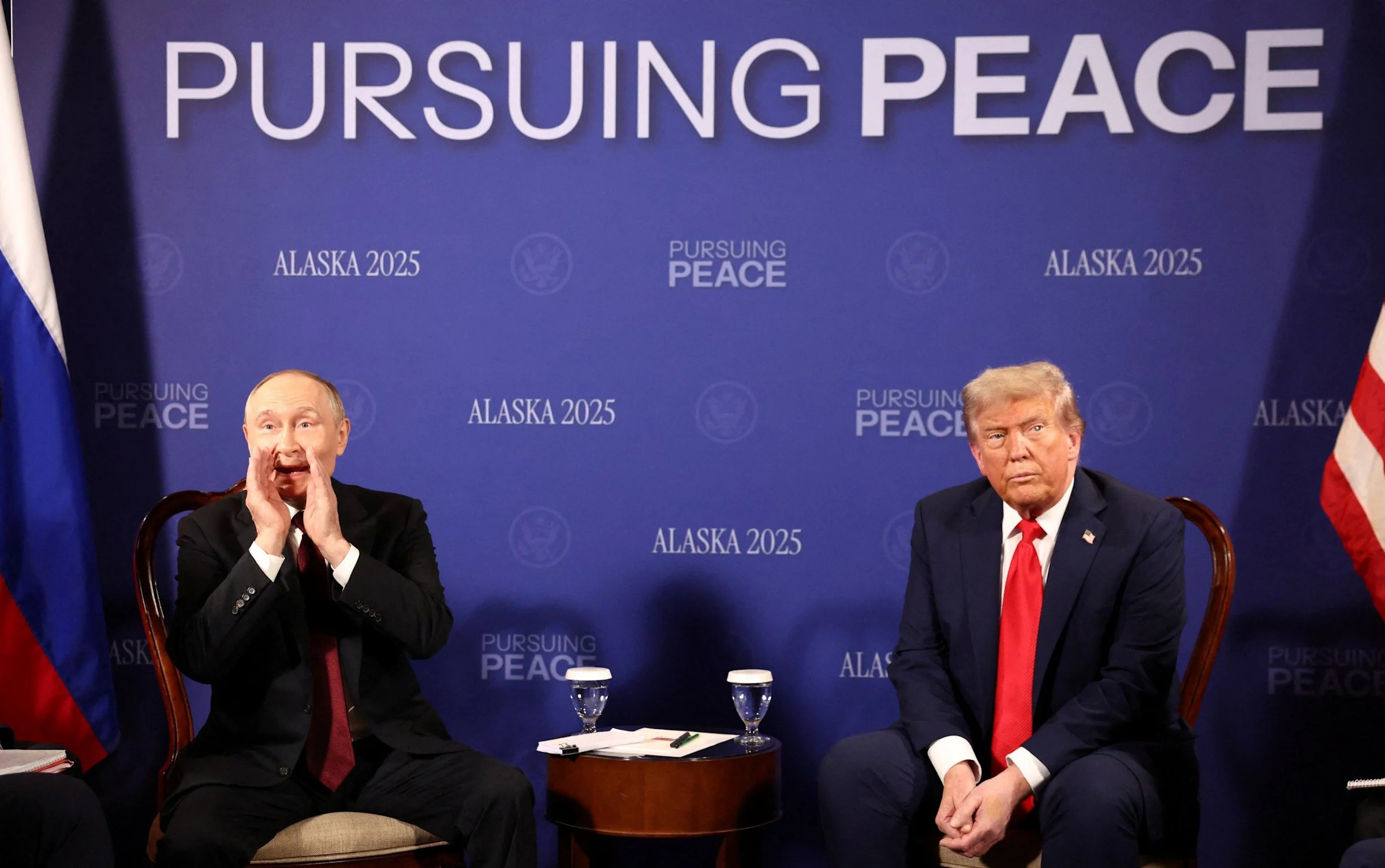Vladimir Putin winced as he realised, at least momentarily, that he was not in control.
No number of Russian agents armed with bulletproof suitcases could shield him from being pelted by the sorts of questions he had managed to avoid since he ordered the invasion of Ukraine.
Sitting next to Donald Trump in front of a blue wall emblazoned with “pursuing peace” ahead of their high-level talks in Alaska, the Russian despot was in unfamiliar territory.
As one reporter shouted, “Mr Putin, will you break your ceasefire?” it was clear he was not in a cocoon of Kremlin mouthpiece Russian media, but surrounded by US journalists determined to hold him to account.
His wry smile evaporated into one of alarm. He looked pleadingly to the left and furrowed his brow.
“Will you commit to not killing any more civilians?” another reporter yelled. Putin put his hands to his mouth and appeared to say something, before the press were swiftly removed.
The moment was a brief but stark reminder to the Russian leader that while Mr Trump may have rolled the red carpet out for him, he is a man with an International Criminal Court warrant for his arrest and on the sanctions lists of most Western governments.
After the room descended into a chaotic shouting match, the gaggle of reporters were ushered out.
It was then that Putin, Mr Trump and their advisers began highly-anticipated closed-door talks.
Less than an hour before, Putin had been met with a warm welcome as he stepped onto US soil for the first time in a decade.

At 11.08am local time, after Mr Trump had already descended the steps of Air Force One, Putin finally ventured out of his own aircraft and walked briskly down the stairs to join the US leader.
In a meeting such as this, every fine detail will have been negotiated – including which leader steps out of their aircraft first.
With grey skies and Alaskan mountains setting the scene behind them, the two men walked down respective red carpets and joined one another at Joint Base Elmendorf-Richardson.
In an overt display of warmth that was quickly criticised by US media, Mr Trump grinned and applauded as he waited for Putin to join him.
When the two were finally face-to-face, they engaged in a lengthy handshake as they exchanged pleasantries.
The images were some of the most extraordinary in recent diplomatic history.
In the 42 months since Russia launched its full-scale war in Ukraine, every Western leader has refused to meet Putin. Yet here was Mr Trump welcoming him.
Standing on the red carpet, having descended the steps of Air Force One a fraction before Putin, Mr Trump applauded the approaching Russian leader before shaking his hand and clasping his arm.
As the two men turned and walked towards a podium that read “Alaska 2025”, a five-ship formation flypast of a B-2 bomber flanked by F-22 Raptor fighters flew above their heads.
The spectacle appeared to take the Russian president by surprise, as he stopped momentarily to get a proper view of the planes overhead.
Credit: X/@Scavino47
Standing on the raised platform quickly erected for this photo-op, the two men stood with their arms by their sides, both looking awkwardly rigid.
It was then that US journalists began firing the first of many questions at the Russian leader.
“Did you underestimate Ukraine?” one reporter shouted. Another asked if he would stop killing Ukrainian civilians. Putin pointed at his ear, suggesting that he could not hear.
Putin asked if he will “stop killing civilians”
It was at this moment that an apparent last-minute offer was made for the Russian president to ride to the summit venue alongside Mr Trump in the Beast, the US presidential limousine.
The two leaders had been due to be picked up separately on the tarmac after arriving on their respective flights.
Putin’s “Aurus” limousine, complete with Russian number plates and a flag on its bonnet, had been waiting to ferry him to the talks.
But they both slipped into the eight-ton armoured car with only two security officials accompanying them in the front, raising suspicions in US media about the conversations that were had on the short drive across the military base.
As the car drove away, cameras captured Putin sporting a beaming smile and waving his hand to the crowds.

The ensuing chaotic press conference was held in the moments before the official talks, marking the first time that the leaders had come together for a face-to-face for a bilateral meeting in six years.
Mr Trump was flanked by Steve Witkoff, the Middle East envoy who has previously negotiated with Putin, and Marco Rubio, the US secretary of state.
Mr Rubio greeted Putin with a stern handshake, but appeared far more jovial with Sergei Lavrov, the Russian foreign minister, with whom he has been holding regular phone calls.
While Mr Trump had initially planned to carry out discussions one-on-one, the president’s team announced that the meeting had been changed to a three-on-three just hours before the meeting was set to take place.

The meeting lasted around three hours, half of the time that had been touted by Russian media outlets ahead of the gathering.
It was reported that a lunch between Putin and Mr Trump had also been cancelled, suggesting that their talks had gone badly.
The world’s media was summoned to a press conference, with one question looming: would the US president appear alone?
If the meeting had gone poorly, Mr Trump had declared, he would not stand side-by-side with Putin and brief the press.
But as the seats in the auditorium filled up, two podiums remained on stage, and a Russian speaker sound checked the lectern reserved for Putin.
If the Russian leader had appeared slightly untethered at the beginning of the day, he was now back in control.
It was Putin, not Mr Trump, who began the press conference, a detail that even the Trump-loyal network, Fox News labelled as “really stunning”.
Putin said he wanted the war to end but that he was worried about Kyiv and European capitals “throwing a spanner in the works”.
No details of a ceasefire were provided, but Putin did offer Mr Trump something that he wanted: recognition that the war would not have started if he were president in 2022.
“Today when President Trump said that if he was the president back then there would be no war and I’m quite sure that it would indeed be so,” the Russian president said, translated to English for reporters in Alaska.
Mr Trump, stood at his presidential lectern, stared straight back, offering the slightest nods of approval in response.
Credit: Anadolu Agency via Reuters
For months, the US president has been telling anyone who would listen that he believes that the Russian army would not have invaded Ukraine if he had beaten Joe Biden and retained his place in the White House for a second consecutive term.
His Russian counterpart’s willingness to acknowledge the dubious claim served as the vindication that the US president had been seeking.
It was an olive branch from Moscow reminiscent of their last meeting in Helsinki in 2018, when Putin, standing beside Mr Trump at a joint press conference, insisted that Russia had not interfered in his election victory.
Mr Trump described his counterpart’s missive as “profound”, before heralding the talks as “productive”. However, he admitted that sticking points remained, “one the most significant”. He did not elaborate on what that was.
US fighter jets provided an escort for Putin’s Ilyushin Il-96-300PU plane as it flew west from Alaska back toward Russian airspace.
But some 12 hours after the press conference, details emerged of the talks that suggest Mr Trump did make some progress with Putin in those few hours.
During a call with Volodymyr Zelensky, Ukraine’s president, and a group of European leaders following their meeting, Mr Trump outlined the demands Putin had made.
A European official told The Telegraph the Russian despot said he would end the war if Ukraine surrenders the Donetsk region in exchange for unspecified territorial concessions.
While Russia holds the majority of the Donetsk region, Ukraine is still in control of large swathes of the oblast, which makes up its main line of defences in the east.
This concession would give Russia, which already controls a significant amount of Ukraine’s Luhansk region, control of the eastern Donbas.
Such territorial gains would give Russia an unabridged staging post for future attacks into the regions of Zaporzhia and Dnipropetrovsk in the direction of Kyiv.
It also prompts concerns that Mr Zelensky will be pressured to accept Putin’s demands as part of Mr Trump’s quick-fire attempt to end the war.
In one notable gear change, Mr Trump said the US would be ready to participate in “Article 5-style” security guarantees for Kyiv, referring to Nato’s mutual defence clause.
It is the first time that the president has indicated he would join the Coalition of the Willing of European countries, led by the UK, France and Germany, planning to police any ceasefire agreement.
Putin also tabled a demand for “protections” for the Russian Orthodox Church in Ukraine, which Mr Zelensky banned last year after accusing it of being complicit in Putin’s war.
The move provided the Russian president with an excuse for his invasion, claiming that military action was taken to protect Russian speakers and culture in Ukraine.
On Monday, Mr Zelensky will fly to Washington to discuss Putin’s list demands and Mr Trump’s peace plans. The UK, France and Germany are planning to join the meeting.
The Alaska press conference had ended with no questions, helping Putin dodge the scrutiny that had made him squirm earlier that day.
If the Russian leader had been made to feel uncomfortable under the glare of dozens of broadcast cameras, he would now return the favour to his American friend.
“Next time in Moscow,” Putin said, breaking into English for full effect.
“Ooh, that’s an interesting one,” Mr Trump replied. “I don’t know. I’ll get a little heat on that one, but I could see it possibly happening.”
Yahoo News – Latest News & Headlines
Read the full article .


